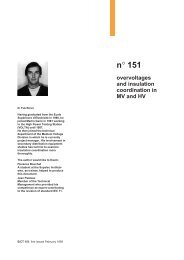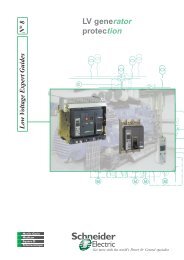sepam 20 user manual - Schneider Electric
sepam 20 user manual - Schneider Electric
sepam 20 user manual - Schneider Electric
Create successful ePaper yourself
Turn your PDF publications into a flip-book with our unique Google optimized e-Paper software.
Modbus communication Modbus protocol<br />
Characterization of exchanges<br />
The Modbus protocol may be used to read or write one<br />
or more bits, one or more words, the contents of the<br />
event counters or the contents of the diagnosis<br />
counters.<br />
DE50378<br />
Modbus functions supported<br />
The Modbus protocol used by Sepam is a compatible<br />
sub-group of the RTU Modbus protocol.<br />
The functions listed below are handled by Sepam:<br />
b basic functions (data access):<br />
v function 1: reading of n output or internal bits<br />
v function 2: reading of n input bits<br />
v function 3: reading of n output or internal words<br />
v function 4: reading of n input words<br />
v function 5: writing of 1 bit<br />
v function 6: writing of 1 word<br />
v function 7: high-speed reading of 8 bits<br />
v function 8: reading of diagnosis counters<br />
v function 11: reading of Modbus event counters<br />
v function 15: writing of n bits<br />
v function 16: writing of n words.<br />
b communication-management functions:<br />
v function 8: Modbus diagnosis<br />
v function 11: reading of Modbus event counter<br />
v function 43: sub-function 14: reading of identification.<br />
The following exception codes are supported:<br />
b 1: unknown function code<br />
b 2: incorrect address<br />
b 3: incorrect data<br />
b 4: not ready (cannot process request)<br />
b 7: not acknowledged (remote reading and setting).<br />
Response time<br />
The communication coupler response time (Tr) is less<br />
than 15 ms, including a 3-character silence<br />
(approximately 3 ms at 9600 bauds).<br />
This time is given with the following parameters:<br />
b 9600 bauds<br />
b format: 8 bits, odd parity, 1 stop bit.<br />
Synchronization of exchanges<br />
Any character that is received after a silence of more<br />
than 3 characters is considered as the beginning of a<br />
frame. A silence of at least 3 characters must be left on<br />
the line between two frames.<br />
Example: at 9600 bauds, this time is equal to<br />
approximately 3 milliseconds.<br />
PCRED301005EN - 06/<strong>20</strong>08<br />
DE80299<br />
DE80300<br />
PE80298 Protocol principle<br />
reply<br />
request<br />
master<br />
slave slave slave<br />
Exchanges are initiated by the master and include a request by the master and a<br />
reply by the slave (Sepam). Requests by the master are either addressed to a given<br />
Sepam identified by its number in the first byte of the request frame, or addressed to<br />
all the Sepam (broadcasting).<br />
broadcasting<br />
master<br />
slave slave slave<br />
Broadcast commands are necessarily write commands.<br />
No replies are transmitted by the Sepam.<br />
master<br />
request<br />
reply<br />
slave<br />
It is not necessary to have a detailed knowledge of the protocol unless the master is<br />
a central computer which requires the corresponding programming. All Modbus<br />
exchanges include 2 messages: a request by the master and a reply by the Sepam.<br />
All the frames that are exchanged have the same structure. Each message or frame<br />
contains 4 types of data:<br />
slave function data CRC 16<br />
number code zones check zone<br />
b slave number (1 byte): this indicates the receiving Sepam (0 to FFh).<br />
If it is equal to zero, the request concerns all the slaves (broadcasting) and there is<br />
no reply message<br />
b function code (1 byte): this is used to select a command (read, write, bit, word) and<br />
to check that the reply is correct<br />
b data zones (n bytes): these zones contain the parameters relating to the function:<br />
bit, address, word address, bit value, word value, number of bits, number of words<br />
b check zone (2 bytes): this zone is used to detect transmission errors.<br />
5/3<br />
5

















